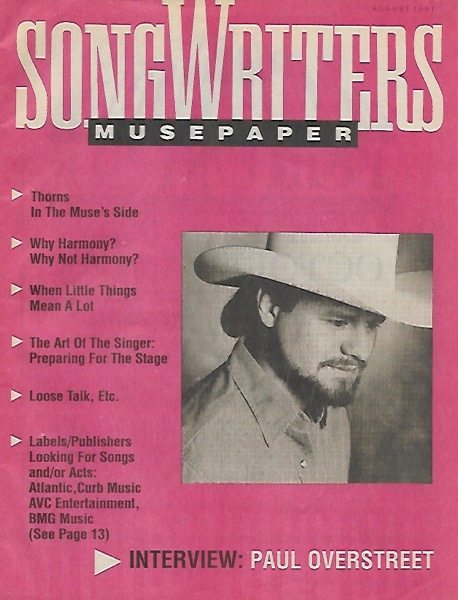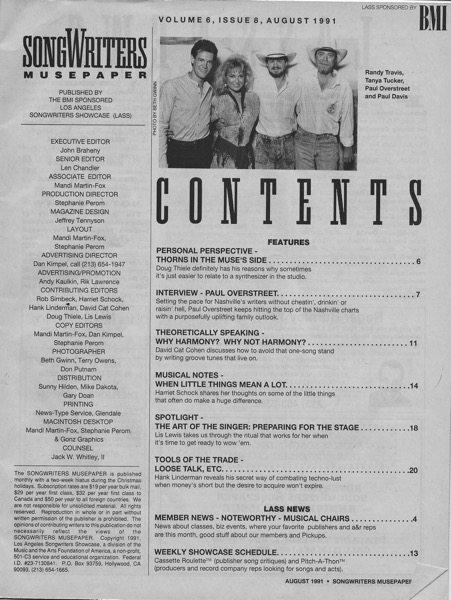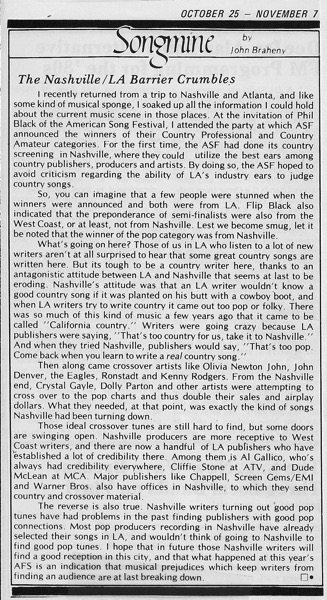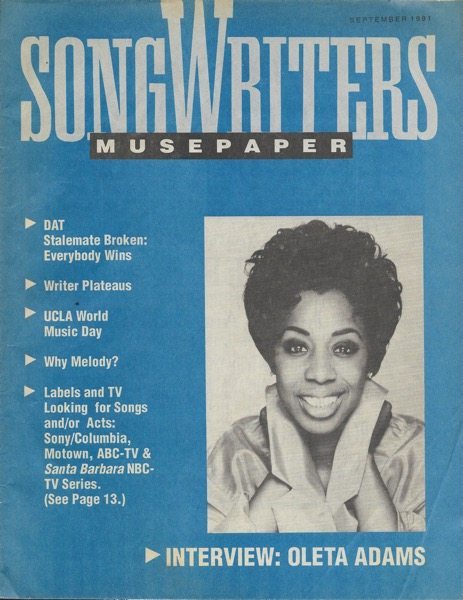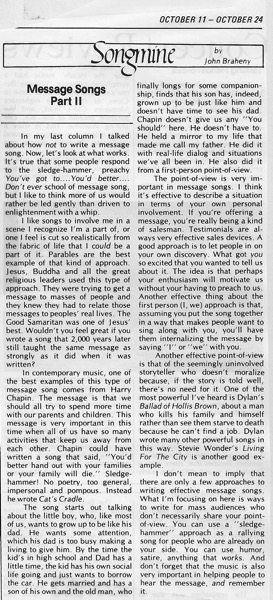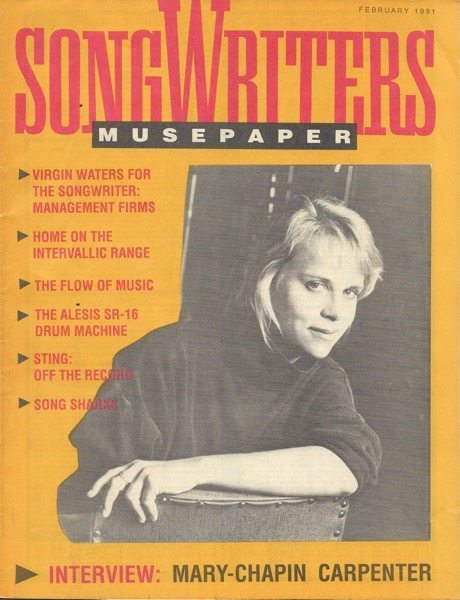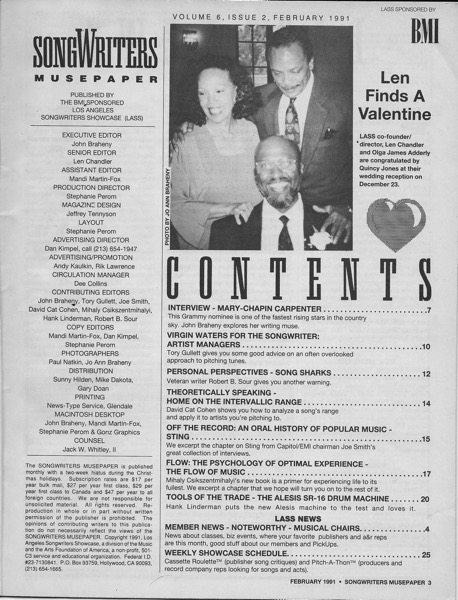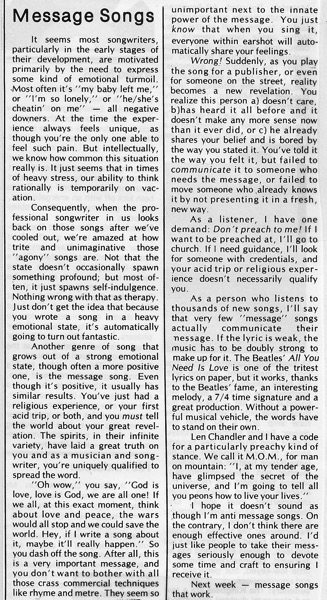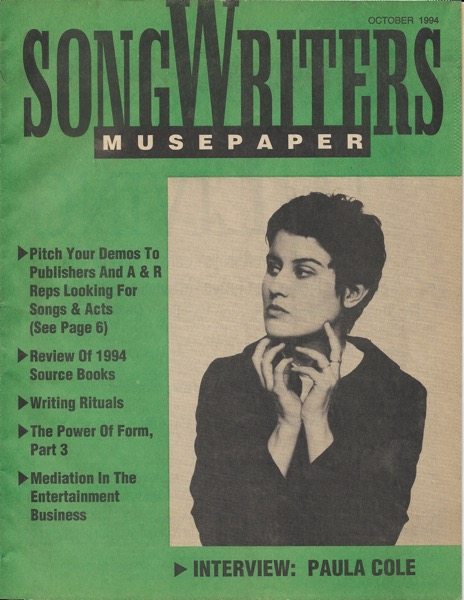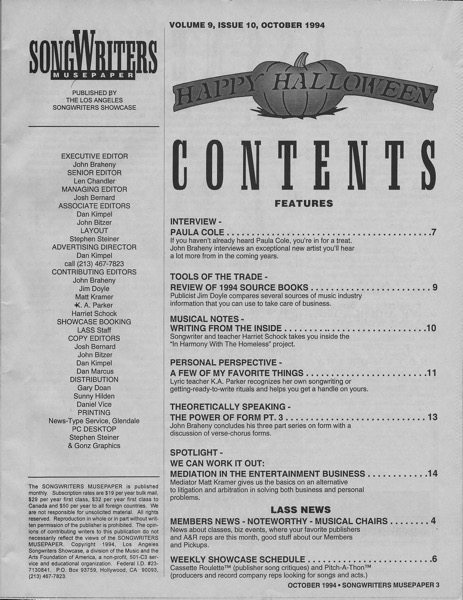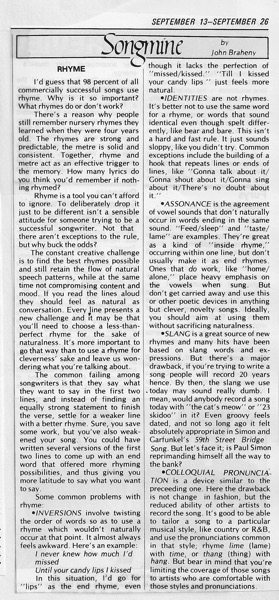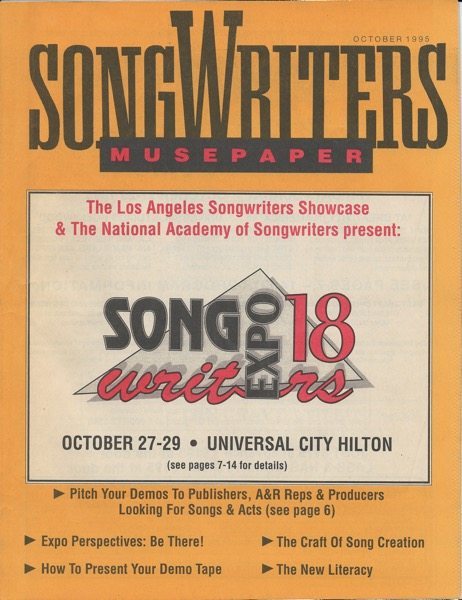A John Braheny Songmine column from the archives…

Accession Number: C000000137-024-002 Document/Digital File, “Songmine: Tough Enough To Publish Yourself? by John Braheny”, OCR converted text under same Accession Number
(Digitally converted text. Some errors may occur)
Songmine by John Braheny
TOUGH ENOUGH TO PUBLISH YOURSELF?
Let’s not debate the fairness of the traditional contract split that gives publishers 50 percent of the copyright on a song. That’s the way it always has been, and that’s the way it is. The fact is that a good publisher can do a lot for you given enough incentive, and that 50 percent is the incentive After all, this is the music business. Let’s look first at what the publisher can and should do for you.
1) Secure recordings of your songs in the United States.
2) Make sub-publishing deals with foreign publishers to get them recorded in other countries.
3)Collect your royalties from record companies and sheet music distributors.
4) Make deals for the sales of sheet music. If your song is a hit, there’s a good market in songbooks, choral and band arrangements.
5) Exploit your songs via airline tapes, commercials, and if the song is successful (don’t cringe) Muzak.
Now, let’s discuss the advantages of having your own publishing company. It’s important because that 50 percent could represent a lot of bread. On the other hand, 50 percent of zero of zero. We at ACSS talk to a lot of songwriters who just “want to own my own company.” Unless you have songs that are about to be recorded, it’s just an ego trip. MBI and ASCAP won’t do the paperwork or clear a name for your company unless you give them a release date on the recording. They found that they were doing tons of needless paperwork to set up companies that never secured a recording. So, you should have a more logical reason than just “wanting your own publishing outfit” if you’re actually going to do it. Here are a few:
1) You’re a good commercial songwriter whose tunes are very coverable and you already have a lot of contacts among producers and artists who’re interested in your songs. In other words, you’re in a position to fulfill a publisher’s major function: getting covers. You should be aware, though, that it takes a lot of time, and follow-up is very important. There are other qualities you should have if you want to do a good job on your own behalf.
You should have the ability to “sell” yourself. Some people sell represent others better than themselves. You should be an aggressive self-starter . You should have the ability to be both creator and businessperson. (Yes, it can be done, and yes, it’s a myth that creative artists always make poor business people.) You should have a great casting sense, that lets you present the right song to the right artist at the right time. Publishers’ reputations are built on their credibility. That’s what gets them back through those producers’ doors’ again.
2) You’re independently wealthy or have financial backing, you write coverable tunes and you can afford to hire someone with with experience and contacts to exploit your songs.
3) You have your own production company or record company and you’re releasing your own product.
4) You’re a recording artist and you’re recording your own songs, and therefore already doing a large share of what a publisher can do for you.
5)You’ve already written commercially successful songs, and it’s easy for you to get in those doors.
6) You’re writing with someone who does well as their own publisher, and you can negotiate a portion of the rights for your own company. If your co-writer is a staff writer with a major company, you’ll find this all but impossible.
7) You’re a writer/artist like Joni Mitchell or a punk band whose songs are unlikely to be recorded by other artists. So you don’t need a publisher.
If you honestly feel you can do a publisher’s job as well as he or she can, go for it. If you’re capable of hustling for yourself, you’ll have the satisfaction of knowing that someone with your best interests at heart is on the job. You won’t be constantly wondering whether the publisher is ‘sitting on your songs,’ or why he’s avoiding your calls. If someone is not on the case, you have only yourself to blame. Can you handle that?
Another alternative is an administration deal for 15 to 30 percent, depending on how much you want them to do. Next issue, I’ll discuss that species of deal and the mechanics of starting your own company.
Previously in the Songmine Collection:
- Songmine: The Nashville/LA Barrier Crumbles by John Braheny
- Songmine: Message Songs Part 2 by John Braheny
- Songmine: Message Songs Part 1 by John Braheny
- Songmine: Rhyme by John Braheny
- Songmine: “The Knack” A 3rd Point of View by John Braheny
- Songmine: For the non-writing artist: Where do you find original material? by John Braheny
- Songmine: For the non-writing artist: Why you need original material by John Braheny
- Songmine: Scoring Films on a Low Budget Part 6 by John Braheny
- Scoring Films on a Low Budget Part 5 by John Braheny
- Songmine: Scoring Films on a Low Budget Part 4 by John Braheny
- Songmine: Scoring Films on a Low Budget Part 3 by John Braheny
- Songmine: Scoring Films on a Low Budget Part 2: Research and Spotting
- Songmine: Scoring Films on a Low Budget Part 1
- Songmine: The Chances for Advances by John Braheny
- Songmine: What a Record Company Needs to Know – Part 6: Attorneys by John Braheny
- Songmine: What a Record Company Needs to Know – Part 5: The Professional Team by John Braheny
- Songmine: What a Record Company Needs to Know – Part 4: What Makes This Act Marketable? by John Braheny
- Songmine: What A Record Company Needs to Know : Part 3
- Songmine: What A Record Company Needs to Know: Part 2 by John Braheny
- Songmine: What A Record Company Needs to Know: Part 1 by John Braheny
- Songmine: Getting the Most from the Trades Part 4
- Songmine: Getting the Most from the Trades Part 3 by John Braheny
- Getting the Most from the Trades
- Songmine: Publishing III
- Songmine: Leave Your Ego at the Door
- Songmine: “Feedback: Why some publishers won’t give it”
- Songmine: Dealing with Rejection by John Braheny
- “Music in Print” – A Songmine Column from Music Connection Magazine March 19-April 1, 1981
About Songmine and Music Connection Magazine:
John Braheny met Eric Bettelli and Michael Dolan right before they were going to publish Music Connection magazine. Eric and Michael wanted to get their publication out to as many songwriters as they could. They had already heard of the LA Songwriters Showcase, and of John and his partner, Len Chandler. John’s goal was to advertise the schedule of guest speakers and performers at the weekly Showcase… so they made a deal.
They published John’s Songmine column (he had never before written a magazine article!) in their very first edition, in November 1977. Trading out the column for advertising, this arrangement continued for many years. Plus, Eric and Michael came to the Showcase each week and distributed free copies to the songwriters!
Those articles became so popular that (book agent and editor) Ronny Schiff offered John’s articles to F&W Media, where they became the backbone of John’s textbook, The Craft and Business of Songwriting. As a follow-up, Dan Kimpel (author, songwriter, teacher), who had also worked at LASS, took on the Songwriting column at Music Connection magazine which continues to this day! You can subscribe to get either hard copies or online.
